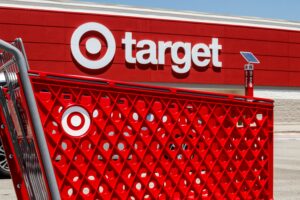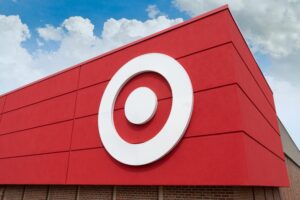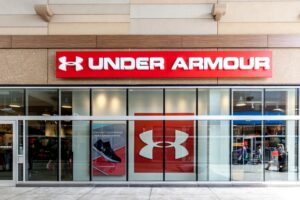July 13, 2006
Frequenting Target: Is More Too Much?
By Rick Moss
Retail Forward released some key highlights yesterday from its ShopperScape-based report, Bull’s-eye on the Target Shopper, and headlined the finding that the cheap chic
leader is “the most-shopped retailer in the United States second only to Wal-Mart.”
Target’s greatest strengths continue to be in the more occasional shopping trip categories, such as children’s apparel, home fashions, small appliances and toys. And yet, the
retailer’s “stickiness” quotient is really high (second, of course, only to you-know-who). According to Retail Forward, “two-thirds of Target’s past six month customer base returns
to its stores on a regular basis.”
All told, if you live in this country, there’s a one in four chance someone from your household is going to hit a Target, Target Greatland or SuperTarget each month. However,
the ShopperScape research shows that only eight percent of primary household shoppers go to Target on a weekly basis, a quarter the figure of Wal-Mart. Although one might think
monthly frequency would be a satisfactory position for Target, with the expansion into food and everyday basics as its main strategy, the push to increase shopper visits continues.
Not that there’s any direct correlation drawn by Retail Forward, but it’s interesting to note that Target’s new emphasis on grocery is still not moving the needle in terms of
shopper preference for those categories; while at the same time, the retailer is losing share of shopper preference in some of the occasional purchase categories: books; consumer
electronics; CDs/DVDs and soft home fashions. Is Target taking its eye off the ball?
Discussion Question: Would becoming a weekly destination weaken Target?
Target has drawn critical praise for doing what its name implies: picking its objectives carefully and maintaining focus in its marketing and merchandise
planning. It seems to me that the stated goals of becoming more of a weekly destination takes them down the “trying to be everything to everybody” path.
Sandy Skrovan of Retail Forward describes the quintessential Target shopper as “a desirable shopper niche – young affluent families typically cushioned
from economic fluctuations such as high gas prices and inflation.” That seems like an accurate portrait and a very worthwhile market position. As Target attempts to broaden its
everyday appeal, I hope they don’t start taking this core group for granted.
Discussion Questions
Poll
BrainTrust
Recent Discussions







It’s too soon to abandon the effort, and they are actually improving over time. But we cited this disconnect between gm and grocery in a cover story back in January. “Target, like a growing number of companies, breaks out its shoppers more by attitudinal segments than by demographics. It would be a significant concern if its least desirable attitudinal segment turned out to be the one that also indexes highest on groceries, as one source says is likely to be the case,” as we said back then. Of course food is integral to Target’s efforts to drive increased shopper frequency. Target has been adding more food in more stores. Company-wide, same-store transaction counts have risen by about 3% lately, with stronger results coming from SuperTarget than Target’s traditional stores. It’s just that many of Target’s highly desirable core GM shoppers are not buying their groceries at SuperTarget, but at upscale supermarkets — especially in metro areas where such high-end competitors exist. It does seem that Target wants to be upscale and trendy in GM, but cheaper than Wal-Mart on groceries. That’s a disconnect, and it’s trouble.
The big secret for the consumer public at-large is that Target’s prices are pretty much the same on like-items as Wal-Mart. Add a more pleasant shopping environment, more fashionable merchandise and higher quality items in some areas and you have the potential for Target to really move shopping frequency and rings higher.
I have to agree with some of the comments about Target’s food business. It still does not have enough of a focus of the company’s business to make much of an impact, positively or negatively, at this point. On the other hand, there are signs the company is making progress in differentiating itself on the grocery front with items such as its Choxie candy line, Archer Farms Italian sodas, Archer Farms Free Trade and Organic Certified Tierra Del Sol whole bean coffee, LIFElong super-premium pet food line and other items that are consistent with Target’s better quality at low prices image.
Target, more than likely, could do very well without grocery, and as someone mentioned, should just keep an eye on its current marketing strategy, and continue to design its selected niche departments. So be it.
If Target does want food to be part of its offering, then, as someone stated, create a specialty meals and foods shop within the box. But, this takes time and skills that must be hired, as we all know. Then, Starbucks and other franchise outlets can add to the shoppers’ trip.
Target has positioned itself extremely well! Interestingly, not all retailers have to be like Wal-Mart, or mirror its past competition that no longer exists. Hmmmmmmmm
My comments are more to the grocery side of Target’s offerings. I live in the Twin Cities area of Minnesota. The local news station was reporting this morning that the SuperTargets, when compared with 2 other of the major grocery chains, averaged 8% less on roughly 150 of the same grocery items. I’ve shopped there for groceries, but it’s only when we’ve happened to go to a SuperTarget and it’s kind of a “well as long as we’re here” sort of thought when it’s come to groceries. Friends and co-workers joke that when you run into Target, you spend more than you intended. Maybe some consumers avoid going there for groceries because they don’t want to be tempted by the softlines and hardlines or have the distraction for the other members of their family. Another thought is that when we do shop Target, we’re out and about and having perishables is a bit more inconvenient because you need to get them home soon. When we make a grocery run it’s more of a deliberate run to get them and go back home. The other two chains that are in our area for groceries always have huge incentives such as buy one get one free specials. Target never advertises just their groceries through inserts or at least I haven’t received any. Lastly, I personally would feel guilty to buy the majority of my groceries at Wal-Mart or Target. I know Wal-Mart uses the non-union labor and I assume Target does as well?
The fact is that for now, Wal-Mart has an easier path to improvement. They have the frequent visits. Now they are working on making those visits count by increasing the availability and desirability of high-margin categories for those already in the store buying staples. Target’s layering of grocery items on the other hand, has the opposite effect. They have the high-margin shopper, that shopper does not believe that they will “miss” anything by visiting Target at the same frequency and if they pick up a couple of grocery items on one of those visits, well, there’s an incremental sale in a low margin category for Target.
I’ll add that the fall-back that Target is “more fashionable” is simply no longer true and our research shows that all of that “clean” and “fresh” environment and perfectly-matched apparel doesn’t always resonate with young people who are used to shopping in environments that are louder, more creative and more random (specialty retailers).
Ditto on the comment from Mark H. Regarding Target’s limited offerings in categories such as CE. Another area where coordination and trendiness have taken precedence over breadth of selection. This was undoubtedly by design (pun intended) however; it won’t make Target a go-to destination in those categories. Plenty of consumers make a “fun” trip to Target, realize that they needed a tool or a small electronics item, try to acquire it on the same trip and leave saying “I can’t believe they didn’t even have a….”
Warren mentions the disconnect.
There has been no disconnect at Wal-Mart because it has always been price driven. That could change as it tries to go upmarket.
Target faces a different problem, that is the blending of quality and price into a stew called value that is palatable to a wide range of customers. If they are not close to the the price leader on a national brand grocery item (with their private label a little lower) will the customer perceive their private label soft wear value in a more negative light? Are variety expectations different between between food and non-food? Some customers cannot fill their regular grocery list at a Target. Are Target grocery customers more fragmented in their needs and shopping habits between convenience, shopping enjoyment, health concerns, party shopping, food as a hobby and price? Can the disconnect be bridged?
Time will tell.
OK, we do not have any Super Targets or Target Greatlands near us (although a Greatland is being built) so this comment may not be applicable to them, since I’m not familiar with those formats.
If Target’s strategy is truly to use food to increase the number of trips to the store then it needs to do it in a bigger and better way not just as an afterthought. I would never think of the handful of grocery aisles at my local Target as any type of a destination. The selection is very narrow and the pricing is mediocre.
Target’s strength has always been that you came in to buy a box of laundry detergent that was on sale and along the way you ran into so many cool inexpensive (and I’m guessing higher margin) items, that you ended up spending at least $100. If they are working within the same footprint (not expanding the store to add grocery) I think they are trading high margin sales for low margin sales.
I would imagine a significant percent of customers who shop at Target buy their groceries at Whole Foods, Central Market, and other such retailers and, probably, equal percentage of customers are price sensitive when buying groceries. That’s a dilemma with being a discount retailer for an upscale clientele. It would be risky to only keep organic and pricey groceries as that does not fit the discounter model and sends a conflicting message. At the same time, it’s difficult to change buying habits of avid organic food buyers. I think, Target needs to strategize at local store level by investigating buying habits of the local customers and alter their assortment accordingly to maximize profits.
With the slide of Kmart and other mass merchants into retail oblivion, Target has smartly become the “upscale alternative” to Wal-Mart. Shoppers like duopolies and some choice, and Target provides young, more affluent families a place to shop for fashion and household goods without submitting themselves to the frenetic madness of a Wal-Mart. In fact, many Target shoppers list “ease of shopping” and “less crowded aisles” as their primary reasons for shopping Target.
But increasing shopper frequency at Target among their current shopper base will be more difficult. While Wal-Mart’s entry into discount food was a successful move to increase frequency among their “price-driven” shopper base, Target’s shoppers are more likely to covet freshness, quality and convenience when it comes to their grocery purchases. Consequently, it will be much more difficult to dislodge these shoppers from their primary supermarket that specialize in these services.
Further, Target has serious issues when it comes to other key departments that drive shopper frequency. While Wal-Mart has made a concerted effort to increase their breadth and depth of electronics, CD’s and DVD’s, Target’s offerings in this area are relatively limited. Target’s HBC section, while more competitive to Wal-Mart than electronics, has similar variety and merchandising issues that limit the number of shoppers who might make an incremental trip to Target for such items.
Target’s best bet is to enhance their breadth of offerings in these key departments to increase traffic. While I do not expect them to abandon their move into grocery, Target’s current food store offerings will likely continue to fall short of their own shopper’s expectations that have been established by the likes of Publix, Bashas, HEB, Hannaford, Harris Teeter, Kroger, Wegmans, et al.
To follow industry-savvy Warren Thayer turns this bull into a cautious bear. Warren’s knowledge of Target’s strategy seems more accurate than mine. Thus I will comment cautiously.
Each time I go into a Target stores, and there is a gaggle of them in the Twin Cities, I am impressed by the cleanliness of their stores, their orderliness, their customer profile and the helpfulness of their employees. While they are focusing more on groceries and food, I haven’t reached the conclusion that they are trying to out price Wal-Mart in groceries even as they push an endless assortment of tony-packaged private label products.
Target targets the people who have proven to be the niche that increases their same-store sales and boosts their overall store profits. The trend is solid and Target’s future will continue to unfold solidly — whether or not it becomes an everyday destination.
I have always questioned Target’s whole-hearted jump into grocery retailing, but I do not believe there is any disconnect between Target and its shoppers.
Quite the contrary, Target knows its customers and potential customers better than anyone in the business. They do extremely detailed research on both demographics and attitudes. Then, they adjust the merchandise mix. We’re seeing this in branded and private label apparel, home furnishings and food.
It depends on location, but I don’t think Target is going to be widely known as a weekly shop for food. However, they are, increasingly, a weekly destination for general merchandise and HBC products. People are making it a regular stop to see what’s new, just as they do at Trader Joe’s where you might see 15-20 new items weekly.
Target may not have this volume of new items, but their seasonal and weekly promotions keep customers interested. Whether that holds true for food remains to be seen.
Target grocery isn’t distinctive. If they partnered with someone distinctive (Trader Joe’s, Whole Foods) or created their own special positioning, they’d have a winning combo. Target’s merchandising strengths are the categories they uniquely design. Like grocery, they’re unlikely to have unique designs in music, movies, or books, so they’re weaker in those areas. It doesn’t pay to run me-too categories.
Target has been trying to increase trips for at least the past 3 years. However, most of that initiative has used HBA and grocery non-food items to draw traffic. Food, per se, is not as big a focus area as these other categories. Moreover, the Super format is still only a little more than 10% of their stores. I think Target’s mix has been adjusted in their new prototypes, but that their eye is on the ball of where the margin is made in their boxes.
If the goal of Target is to become a weekly destination, then I wouldn’t, at this point in time, argue that it is a mistake. The management team at Target has in the past few years done a remarkable job. They seem to always be on target (couldn’t resist the pun) and are constantly delivering superior results.
The store format, the cleanliness, brightness and accessibility of products has greatly improved. In time, more and more people will start coming to Target with greater frequency.